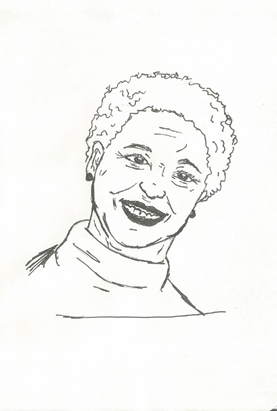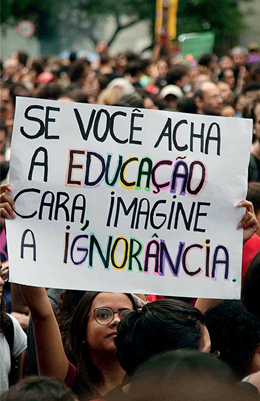by Artionka Capiberibe
Translated by Lucas Thixbai Fraga Reviewed by Matheus Lucas Hebling
Originally published in Portuguese April 10, 2020 link
It seems strange to say that a disease that is just beginning to be discovered is a long-standing family member of some populations that live on this planet. However, this is the case concerning the experience that is beginning to be lived by Brazilian indigenous peoples with COVID-19. This is the case because viruses and bacteria have been allied for centuries with the greed of economic exploitation, acting together with this in the death of indigenous populations. Whooping cough, smallpox, chickenpox, measles, malaria, bubonic plague, typhus, diphtheria, conjunctivitis, and flu are diseases whose pathological agents exterminated or substantially reduced people who had no immune barrier to the ills brought with the supposed civilization. Microorganisms change, but the massacres remain.
In the new coronavirus scenario, as soon as the quarantine guidance given by WHO became palpable here, the Articulation of Indigenous Peoples of Brazil (APIB) postponed the holding of the Terra Livre Camp (ATL) – Free Land Camp – of 2020, the main pan-indigenous political mobilization carried out in the country, which usually gathers about 4 thousand indigenous people from all regions. To have a dimension of the meaning of this act, the ATL has been happening in Brasília continuously for fifteen years, always in the month of April, which is called Abril Indígena (Indigenous April), redefying that folkloric day. Its central struggle is in favor of the right to land, but it is also under pressure and demands the services that, by law, the State owes to indigenous populations, including the provision of health care in this role. As Abril Indígena is a crucial moment of visibility of the problems and violence faced by indigenous populations, its postponement is equivalent to postponing the World Olympics. For this reason, recently, APIB decided to keep the ATL in April, but to do it on virtual platforms: social networks, press, and digital media will be the ground where the tents of the 2020 camp will be set up.
To the specific theme of COVID-19, one of APIB’s actions to face the pandemic was to demand that the Brazilian Federal government immediately implement a plan for the prevention and treatment of coronavirus cases among indigenous populations, guaranteeing, among other things: the protection of their territories (regardless of the regularization phase in which they find themselves), attention to the lands where peoples living in voluntary isolation, known as isolated tribes, and the suspension of evictions in lands that were taken over by the indigenous peoples themselves, tired of the slowness of the action of the State. This document also calls for the inhibition of invaders in indigenous lands, such as squatters, loggers, miners, squatters and others; and the guarantee of the improvement of the indigenous health subsystem, with preventive measures to avoid risks of contamination of the coronavirus in indigenous lands close to urban centers and / or when people move to cities in search of medical and hospital assistance.
Among APIB’s claims, there is one that I would like to highlight, the one that calls for the immediate revocation of Ordinance no.419 / from Presidency of the Republic’s Office, of March 17, 2020, issued by Funai (National Indigenous Foundation) to establish temporary preventive measures for COVID-19. In the ordinance, there was an article, the 4th, which allowed Funai’s Regional Coordination (CR) to authorize contact with “isolated indigenous communities”, noting that this would happen when there was a need for activities considered essential to the survival of these groups. What is presented as zeal is, in reality, a kind of trap, because the Ordinance would give powers to a part of the organ structure that has neither the attribution nor the competence to act with the peoples in voluntary isolation, this being an exclusive function of General Coordination of Isolated and Recent Contact Indians (CGIIRC), in articulation with the local Ethno-Environmental Protection Fronts. With pressure from APIB, reinforced by a recommendation from the Public Ministry (from the 6th CR), Funai revoked the article.
The 4th article of the Ordinance, in addition to being a flagrant disregard for laws protecting indigenous rights, goes against the teachings of history, which show how contact with invaders (who are immune to diseases and the ideologies of domination they carry) can trigger the annihilation of entire indigenous populations. In its note, APIB mentions that Funai’s orientation may be linked to “unexplained interests”, adding that it would have denounced such interests on other occasions. Here we find another old acquaintance of the indigenous populations, the religious missions. In January of this year, APIB repudiated the appointment of a pastor from the proselytizing organization Missão Novas Tribos do Brasil (New Tribes of Brazil Mission, MNTB) to head the CGIIRC. Despite the reactions, to the contrary by various organizations that support indigenous rights, the missionary was installed and occupies the position responsible for taking care of the peoples considered the gold mine of fundamentalist evangelical missions: the peoples in voluntary isolation.
Another fact that draws attention due to the coincidence with that proposed in Ordinance 419 and which was denounced by the Union of Indigenous Peoples of the Vale do Javari (UNIVAJA) — in the Brazilian State of Amazonas — was the attempt made by a missionary from the Frontier International organization to enter the Vale do Javari Indigenous Land, an of which concentrates the largest number of people not contacted. Break the voluntary isolation of others, when what governs today for world health is everyone putting himself or herself in social isolation. How to classify this attitude? Could it be that now that we have to be confined, to save each other’s skin, can the sense of voluntary isolation of small indigenous populations living in the Amazonia rainforest make sense beyond the scope of experts on the topic?
However, the indigenous context in Brazil is complex. If on one hand there are people in voluntary isolation, at the other, there are those who live in urban centers and, in the middle of that, those who live in transit, more or less, between villages and cities. What brings this complexity together is certainly the enormous vulnerability in which everyone is. Today, 04/10/2020, the Special Secretariat for Indigenous Health (SESAI, from the Ministry of Health) discloses the number of 6 cases and 1 death by COVID-19 among indigenous people. The death is that of a Yanomami boy only 15 years old. In addition to the sadness it causes, the consequences of this loss will still be felt. Finally, it is relevant to highlight the fact that SESAI data does not account for indigenous people living in urban centers that the indigenous health system does not cover. It is from these non-villagers that the first death caused by the new coronavirus came, that of an 87-year-old woman from the Borari ethnic group, which occurred in the city of Santarém, State of Pará.
Underreported, with precarious assistance, with the real risk of contagion spreading rapidly within communities, subject to invasions, the “isolated or registered” indigenous people we identified as an expression of vulnerability indigenous given the development policies of the Brazilian State — they will face the death of a disease again, but this time, history has not put them alone in the tragedy.

ATL (Brasília, 2019) photographed by Artionka Capiberibe *
Artionka Capiberibe is a professor in the Department of Anthropology and Director of the Center for Research in Indigenous Ethnology (CPEI) at the State University of Campinas (Unicamp)
* The photo is a support product of the São Paulo State Research Support Foundation (FAPESP), through the Research Support Project (process no. 2018 / 12386-4). The opinions, hypotheses and conclusions or recommendations expressed in this material are the responsibility of the author and do not necessarily reflect the vision of FAPESP.





